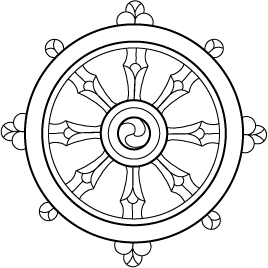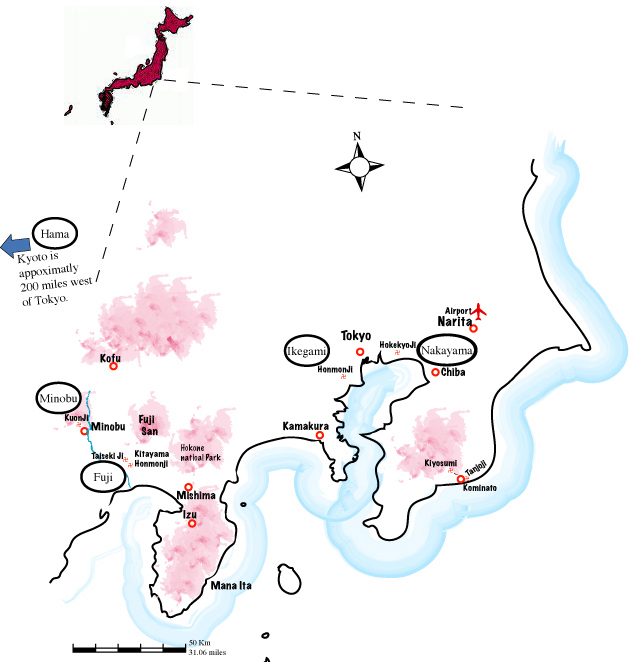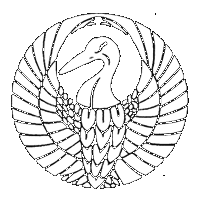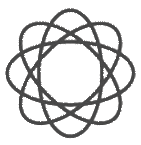
The Lineage of Nichiren Buddhism

The Lineage of Nichiren Buddhism
This is an overview of the lineage and the branches of Nichiren Buddhism since it is often misunderstood in the United States. Nichiren Buddhism is one of the largest lineages of Japanese Buddhism and some of its branches are well represented in the United States. We do not intend to critique of any of the branches of our lineage; however, we will examine some points of difference. This is not a complete study of the history of Nichiren Buddhism; additional information can be found in the links and references provided below.
There are over thirty branches in the Nichiren Lineage of Buddhism, many of which are small and may only be represented by a single temple or area in Japan. Most of the branches have not left Japan and yet a few have spread beyond Japan to the United States, Europe and other parts of the world. This was done through the efforts of various waves of Japanese immigrants. Nichiren Buddhism arrived in the United States with the establishment of the Nichiren Shu Los Angeles Temple in 1914. Despite this early presence, Nichiren Buddhism is not as well known as other forms of Buddhism such as Zen or Tibetan because of its ethnic ties. The branches of Nichiren Buddhism which came to America are Nichiren Shu, Nichiren Shoshu, Kempon Hokke Shu, Nipponzan Myohoji, and Hommon Butsuryu Shu. A few lay organizations also have come to America, including Soka Gakkai, Rissho Kosei Kai and Reiyukai. To understand why and how these branches were born we must start with a little history.
History
Nichiren Shonin (1222-1282) was originally a Tendai monk in the Kamakura period of Japan. The Tendai school dates back to Chih-i (538-597), its founder in China, whose teachings influenced and birthed many different schools. Nichiren Shonin's historical time was filled with many atrocities such as famine, war, class struggle and unstable suppressive government. Many great Buddhist teachers came out of this period since many believed they were entering the age of Mappo (Declining Latter Age of the Dharma). Nichiren Shonin wished to help alleviate the suffering of his parents and the people. To this end, he studied hard and learned everything he could about Buddhist doctrine. He had seen corruption within Buddhism of his time and even in his own lineage of Tendai Buddhism. He set out to reform the Tendai lineage and the Nichiren lineage was born on April 28, 1253.
Nichiren Shonin taught the Lotus Sutra as the highest teaching of the Buddha. We revere the Eternal Buddha Shakyamuni revealed in Chapter 16 of the Lotus Sutra as our teacher and guide. The Lotus Sutra is the core teaching of Nichiren Buddhism upon which all our practices are based. Nichiren Shonin prescribed the chanting of the Odaimoku (Namu Myo-ho Renge Kyo) or sacred title as the main practice of his lineage. Sometimes he would also prescribe chanting chapters of the Lotus Sutra as secondary practice. Through our practice we can elevate the innate Buddha Nature that all living beings possess. We can touch Buddhahood and eventually become Buddhas in our present lives. As we practice for ourselves and others, we follow Nichiren Shonin as Bodhisattvas of the Earth, spreading this teaching to all beings to relieve suffering and reveal the Buddha Land here on earth.
The Lotus Sutra prescribes two styles for spreading of the Dharma: "Shakabuku" the more aggressive form, literally means to break and subdue and is the form of debate; and "Shoju" the more passive form, which is leading by example. Since Nichiren believed that he lived in the Declining Latter Age of the Dharma, he prescribed Shakabuku as the way to teach and spread the Dharma because of the urgency of the times and the capacity of the people. Some lineages of Nichiren Buddhism still use this aggressive form while others, seeing the changes in the world and its peoples, have opted for Shoju as the appropriate method for the 21st century.
Before Nichiren Shonin passed away in 1282, he designated six senior disciples as successors in accord with the custom of his time. Because of their deep and sincere dedication to their master, the senior disciples determined to upkeep and maintain Nichiren Shonin's mausoleum and set up a rotation system at Mt. Minobu where Nichiren Shonin's ashes were interred. It was Nichiren Shonin's fervent wish to be buried on Mt. Minobu. Since the political situation was in a state of unrest and traveling any distance proved to be quite arduous, it soon became apparent that this would not be an easy task. Different disciples ended up far from their brothers and sisters and because they were separated by such great distances, inadvertently created branches of the Nichiren lineage according to their own interpretations of what the Buddha and Nichiren Shonin had taught. However, the doctrine remained relatively consistent among these disciples. This is still true today and most branches of Nichiren Buddhism get along and can agree on the majority of their doctrine. However, some groups have made radical changes in doctrine, adopting new ideas created by priests and lay members of their lineages.
After the first generation of Nichiren Buddhists, five major branches (school) and several Independent Temples would appear. The five major branches are listed below:
|
School or Lineage |
Founder |
Area |
| Minobu | Niko |
Mt. Minobu |
| Fuji | Nikko |
Omosu |
| Hama | Nissho |
Kyoto |
| Ikegami | Nichiro |
Tokyo |
| Nakayama | Nichijo (Toki Jonin) |
Chiba |

Even though a very colorful history follows each of these schools, at this point we will concentrate a little more on the major branches which came to America. Because we are talking about missionary work, we must look to one of the first missionarys in the Nichiren lineage, Nichiji Shonin. Nichiji, one of the six senior disciples of Nichiren Shonin, left Japan following Nichiren Shonin's directive to spread the Dharma around the world. He traveled to northern Japan and crossed into China. As he traveled through Japan he established many new temples in the northern area. We know very little about him after he leaves Japan, even though recently more information has come to the surface as to his missionary work in China.
NICHIREN LINEAGES IN AMERICA
 Nichiren Shu
Nichiren Shu
Today's Nichiren Shu (Nichiren order) is a confederation of four of the original schools (Minobu, Hama, Ikegami, Nakayama) and part of the fifth (Fuji). This excludes one of the Fuji schools of Nikko, some of the other smaller Hokke schools and also some of the schools which arose after World War II. Nichiren Shu's head temple is Kuon-Ji, founded by Nichiren Shonin on Mt. Minobu; its administrative headquarters is located at Honmon-Ji in Ikegami. The organization is sometimes considered liberal in that it gives its temples considerable autonomy in governing themselves. Nichiren Shu promotes academic freedom and established Rissho University where many Buddhist ministers receive their education. In 1972 Nichiren Shu introduced the Shingyo Hikkei (members handbook) in an effort to standardize the manner of service as it was conducted differently from temple to temple. Even with this standardization, slight differences in the style of liturgical services continue. Around the world today, services are conducted not only in shindoku** but in the language native to the country in which practice occurs. [Shindoku is reading of the Chinese characters of the Lotus Sutra with Japanese pronunciation. This form is used based on tradition and out of respect for Kumarajiva, the man who translated many Buddhist teachings with a beautiful melody without losing any of the meaning. This form is used to enhance faith, while chanting in one's native language is used to enhance understanding.]
Under the guidance of its founder Nichiren Shonin, Nichiren Shu follows the teachings of the Eternal Buddha Shakamuni as outlined in the Lotus Sutra. Nichiren Shu considers these teachings to be the complete teachings of the Buddha. The main practice of Nichiren Shu is the reciting Odaimoku (Sacred Title), Na-Mu Myo Ho Ren Ge Kyo. There are also a number of secondary practices such as Shodaigyo, shakyo, shabutsu, and chanting all or part of the Lotus Sutra. Nichiren Shu belongs to the "Nichiren Association" along with other schools such as Kempon Hokke and Nipponzan Myoho Ji. Nichiren Shu runs and supports hospices, schools in India, and world relief organizations; and works in many different areas to support world peace and better understanding between cultures.
Nichiren Order of North America is the organization of Nichiren Shu temples and sanghas in North America. Nichiren Shu came to North America in the early 1900's with Japanese immigrants. The LA California Temple was established in May of 1914 and was quickly followed by the Seattle, WA Temple. A listing of Nichiren Shu Temples and Sanghas in America can be found on the Nichiren Buddhist International website at http://www.nichiren-shu.org or on this website under links. Our temples offer classes in basic Buddhism such as the Four Noble Truths and the six paramitas to advanced study in the Lotus Sutra. To learn more about Nichiren Shu please see the Nichiren Buddhist International Center's website. You can also learn more from the book "Awakening to the Lotus", a guide to history, teachings and practices of Nichiren Shu, also available at the Nichiren Buddhist International Center's web site. A suggested reading list is here.
Nichiren Buddhist International website
Nichiren Shu webpage in Japan (in Japanese)
The image above is the crest (mon) of Nichiren Shu. It comes from the family crest of Nichiren Shonin. It is known as the Tachibana or Mandarin Orange Flower.
 Nichiren Shoshu
Nichiren Shoshu
Nichiren Shoshu is the first of the Fuji schools founded by Nikko, one of the six senior disciples. Nikko left Mt. Minobu after having several disagreements with Lord Hakkii, the Lord of the area. He would later leave his newly established temple, Taiseki-ji in Omosu and found another called Honmon-ji in Kitayama, which is not even a mile away from Taiseki-ji. He remained at Honmon-ji until his death; his mausoleum is located there.
Nichiren Shoshu's head temple is Taiseki-ji located in Omosu near Mt. Fuji. Nichiren Shoshu remained a relatively small lineage until the creation in 1928, of its lay organization, today known as Soka Gakkai (Value Creation Society) or SGI. Through the use of aggressive proselytizing (Shakabuku) Soka Gakkai would expand Nichiren Shoshu all over the world. Nichiren Shoshu and Soka Gakkai separated in the late 90's.
The doctrines of Taiseki-ji would be similar to other Nichiren Buddhist lineages until the 1400's when new doctrine was introduced. The doctrine of Nichiren Shonin as the original Buddha and Shakamuni as a historical figure appeared during this period. This is now one of the several major doctrinal differences between Nichiren Shoshu and all other Nichiren Schools. Another doctrinal change is the idea of superiority of their doctrine over all others, which limits their participation in ecumenical ministries even with other Nichiren Buddhists. This doctrinal shift also caused the split between Nichiren Shoshu and the other Nikko founded schools of Nichiren Buddhism with whom they had been previously associated. A more detailed explanation of the differences in Nichiren Shu, Nichiren Shoshu and Soka Gakkai, may be found in an article originally written by Rev. Tarabini of the Milan Italy Nichiren Shu Temple which is available for download in English here and in Spanish here.
A link to their web page: Nichiren Shoshu.
The image above this entry is the crest (mon) of Nichiren Shoshu.
 Soka Gakkai
Soka Gakkai
The Soka Gakkai, now known as SGI-USA, is probably the most well known of the Nichiren schools in America. Its separation from Nichiren Shoshu occurred in the late 1990s because of serious disagreements between them, some of which are as simple as power struggles between the priesthood and lay leaders of the Soka Gakkai. An example of these disagreements is the issue of building hundreds of community centers without ministers, while very few temples were built. The disagreements soon became heated and many hateful and nasty things were said about the Nichiren Shoshu priesthood which, unfortunately, the priesthood returned in kind.
Some of Soka Gakkai's members can unfortunately be very negative and aggressive about Nichiren Shoshu or other Nichiren based groups in chat rooms. This can cause others to remain distant from the organization or judge them harshly, but this is not necessarily the position of the group as a whole, nor does it represent their doctrine. The Soka Gakkai does have a Buddhist practice based in the Lotus Sutra and has introduced the Dharma to many people around the world.
Founded in 1928 by a school teacher, Tsunesaburo Makiguchi, this organization would take Nichiren Shoshu to a new high with its aggressive form of proselytizing, support of world peace, the concept of human revolution and its appeal to western materialism by encouraging members to chant for material things. Nichiren Shoshu would go from being a small branch to one of the bigger branches of Nichiren Buddhism because of Soka Gakkai. Soka Gakkai doctrine follows Nichiren Shoshu doctrine, as this was their main source and the teachings of Daisaku Ikeda, their current president and leader. See Nichiren Shoshu and the pdf linked article above for more information.
The image above this entry is the crest of Soka Gakkai. It represents the Lotus Flower.
Nipponzan Myoho-ji is a relatively new organization of Nichiren Buddhism, whose founder Nichidatsu Fuji, a Nichiren Shu minister, passed away in 1985 just before his one hundredth birthday. This organization is dedicated to spreading world peace, nuclear disarmament, the end of stockpiling biological weapons, and the end of war in any form. It is known for its peace marches, protests and peace pagodas around the world. Several of the Peace Pagodas exist within the US including the Leverett Peace Pagoda in Massachusetts, the Grafton Peace Pagoda in upstate New York and the Great Smoky Mountain Peace Pagoda in Georgia. Please visit this link to learn more about their organization. The image above this entry is a hand taiko (drum). The Nipponzan Myoho Ji use hand drums while chanting during their peace marches. Many of the other branches of Nichiren Buddhism also use hand drums while chanting.
Kempon Hokke Shu
Nichiju left the Nakayama order in 1384 and founded Myoman-ji in 1389 which is the head temple of that order. The Kempon Hokke is new to overseas propagation. Kempon Hokke is present in America as a result of the spiritual search of ex-Soka Gakkai members.
Independent Movements
Ex-Soka Gakkai members have initiated several independent Nichiren movements within the US. As the disagreements between Nichiren Shoshu and Soka Gakkai became heated, many of the followers were disillusioned. Many members of Nichiren Shoshu and Soka Gakkai had no knowledge of other Nichiren schools, so they left their lineages and created independent sanghas. These movements usually have no ties to traditional or new Nichiren Branches. Some in this movement have unfortunately also contributed to misinformation about Nichiren Buddhism which has spread virally over the internet.
Other Groups
Most of the other groups in the Nichiren lineage which have come from Japan remain small here in the West. Some no longer consider themselves part of Nichiren lineage even though they trace their beginnings to Nichiren Shonin. They are included here as they all have a practice of chanting the Odaimoku, "Na-mu Myo Ho Ren Ge Kyo." Most of them come from the newer groups of Nichiren Buddhism founded either in the 19th century or more recently. These newer branches of Nichiren Buddhism include (Links here are to web pages of these organizations):
More Information
" Fire in the Lotus" by Daniel B. Montgomery, is an out-of-print book which provides a well-done history of Nichiren Buddhism; however, copies may often be found at used book sites on the web. We hope that in the near future one of the many books in Japanese on the history of Nichiren Buddhism will be translated and published in English. For now, most of the history is passed down from small articles and teacher to student in the oral tradition.
A succinct explanation of the differences among Nichiren Shu, Nichiren Shoshu and Soka Gakkai, can be found in a pdf document originally written by Shoryo Tarabini, Shonin, of Renko-ji Temple in Italy, for download in English here and in Spanish here. You will need a pdf reader, such as adobe acrobat reader to view this document.
Articles by Rev. Ryuei McCormick of the San Francisco Sangha which may also be helpful: